Boss Adaptive Distortion DA-2 Handleiding
Boss
Niet gecategoriseerd
Adaptive Distortion DA-2
Bekijk gratis de handleiding van Boss Adaptive Distortion DA-2 (2 pagina’s), behorend tot de categorie Niet gecategoriseerd. Deze gids werd als nuttig beoordeeld door 84 mensen en kreeg gemiddeld 4.8 sterren uit 42.5 reviews. Heb je een vraag over Boss Adaptive Distortion DA-2 of wil je andere gebruikers van dit product iets vragen? Stel een vraag
Pagina 1/2

Owner’s Manual
Before using this unit, carefully read the sections entitled: “USING THE UNIT SAFELY” and “IMPORTANT NOTES” (supplied on a separate sheet). These
sections provide important information concerning the proper operation of the unit.
Additionally, in order to feel assured that you have gained a good grasp of every feature provided by your new unit, this manual should be read in its
entirety. The manual should be saved and kept on hand as a convenient reference.
A battery was installed in the unit before it left the factory. The life of this battery may be limited, however, since its primary purpose was to enable
testing.
Precautions When Connecting
* To prevent malfunction and/or damage to speakers or other
devices, always turn down the volume, and turn o the power
on all devices before making any connections.
* Some connection cables contain resistors. Do not use cables
that incorporate resistors for connecting to this unit. The use
of such cables can cause the sound level to be extremely low,
or impossible to hear. For information on cable speci cations,
contact the manufacturer of the cable.
* If you’ll be using the DA-2 for an extended time, we
recommend that you use an AC adaptor. If you prefer to use a
battery, we recommend an alkaline battery.
* Raise the amp volume only after turning on the power to all
connected devices.
* Once the connections have been completed, turn on power
to your various devices in the order speci ed. By turning on
devices in the wrong order, you risk causing malfunction and/
or damage to speakers and other devices.
When powering up: Turn on the power to your guitar amp
last.
When powering down: Turn o the power to your guitar amp
rst.
* This unit is equipped with a protection circuit. A brief interval
(a few seconds) after power up is required before the unit will
operate normally.
* When operating on battery power only, the unit’s indicator will
become dim when battery power gets too low. Replace the
battery as soon as possible.
Changing the Battery
When the indicator goes dim or no longer lights while the e ect
is on, it means that the battery must be replaced.
Replace the battery following the steps below.
* Since this device consumes a considerable amount of power,
we recommend that you use an AC adaptor.
If using batteries, please use alkaline batteries.
1. Hold down the
pedal and loosen
the thumbscrew,
then open the
pedal upward.
* The pedal can be
opened without
detaching the
thumbscrew
completely.
2. Remove the old battery from the battery housing, and
remove the snap cord connected to it.
3. Connect the snap cord to the new battery, and place
the battery inside the battery housing.
* Be sure to carefully observe the battery’s polarity (+ versus -).
4. Slip the coil spring onto the spring base on the back of
the pedal, and then close the pedal.
* Carefully avoid getting the snap cord caught in the pedal, coil
spring, and battery housing.
5. Finally, insert the thumbscrew into the guide bush
hole and fasten it securely.
Sleep Mode
The DA-2 will enter sleep mode (power conservation mode; only
the bypass sound will be output) after ten hours have passed
since the last time its pedal or knobs were operated, or audio was
input to the INPUT jack.
From sleep mode, you can press the pedal to return to normal
mode.
Disabling Sleep Mode
1. Set the knobs to the positions
shown right.
2. While holding down the pedal, turn on the power.
Insert the connection plug into the INPUT jack.
The CHECK indicator will start blinking.
3. While continuing to depress
the pedal, move the LOW
knob so it’s within the range
illustrated right.
The CHECK indicator will go out.
4. Release the pedal to complete the procedure.
Enabling Sleep Mode (default setting)
1. Carry out the same procedure as described in steps 1
and 2 under “Disabling Sleep Mode.”
2. While continuing to depress
the pedal, move the LOW
knob so it’s within the range
illustrated right.
The CHECK indicator will light.
3. Release the pedal to complete the procedure.
* Battery power continues to be consumed even in sleep
mode. To prevent battery consumption, turn o the power by
removing the plug from the INPUT jack.
Speci cations
BOSS DA-2: Adaptive Distortion
Nominal Input Level -20 dBu
Input Impedance 1 M ohm
Nominal Output Level -20 dBu
Output Impedance 1 k ohm
Recommended Load
Impedance 10 k ohms or greater
Power Supply
DC 9 V: Carbon-zinc battery (9 V, 6F22)/
Alkaline battery (9 V, 6LR61), AC Adaptor
(sold separately)
Current Draw
45 mA
* Expected battery life under continuous
use:
Carbon: Approx. 2.5 hours
Alkaline: Approx. 9 hours
These gures will vary depending on
the actual conditions of use.
Dimensions 73 (W) x 129 (D) x 59 (H) mm
2-7/8 (W) x 5-1/8 (D) x 2-3/8 (H) inches
Weight 420 g/15 oz (including battery)
Accessories
Owner’s Manual,
Lea et (“USING THE UNIT SAFELY,”
“IMPORTANT NOTES,” and “Information”),
Alkaline battery (9 V, 6LR61)
Option
(sold separately) AC adaptor (PSA series)
* 0 dBu = 0.775 Vrms
* The battery that was supplied with the unit is for temporary
use, intended primarily for testing the unit’s operation. We
suggest replacing this with an alkaline dry cell.
* In the interest of product improvement, the speci cations and/
or appearance of this unit are subject to change without prior
notice.
Setting Samples
DA-2 STANDARD SOUND ADAPTIVE CRUNCH
HIGH GAIN A-DIST
Thumbscrew
Battery Housing
Pedal
Spring Base
Coil Spring
Guide Bush
Hole
Battery Snap
Cord
Battery
Snap
9 V Battery
* 5100031748- 01*
Incorrect handling of batteries can cause leakage, overheating, re, or explosion.
Before use, you must read and strictly observe all of the precautions that accompany
the batteries.
AC Adaptor Jack
Accepts connection of an AC Adaptor (PSA series; optional). By using an AC Adaptor, you can
play without being concerned about how much battery power you have left.
* Use only the speci ed AC adaptor (PSA series; optional), and connect it to an AC outlet of
the correct voltage. Do not use any other AC adaptor, since this may cause malfunction.
* If the AC adaptor is connected while power is on, the power supply
is drawn from the AC adaptor.
* We recommend that you keep batteries installed in the unit even
though you’ll be powering it with the AC adaptor. That way, you’ll
be able to continue a performance even if the cord of the AC
adaptor gets accidently disconnected from the unit.
CHECK Indicator
Shows whether the e ect is on or o , and also doubles as the battery check indicator.
The indicator lights when the e ect is on.
* If you’re powering the unit with a battery and the CHECK indicator goes dim—
or doesn’t light at all—when you try to turn the e ect on, the battery is near
depletion and should be replaced. For instructions on changing the battery,
refer to “Changing the Battery.”
* The CHECK indicator shows whether the e ect is being applied or not. It does
not indicate whether the power to the device is on or not.
Panel Descriptions
Pedal Switch
This switch turns the e ect on/o .
Thumbscrew
When this screw is loosened, the
pedal will open, allowing you to
change the battery.
* For instructions on changing the
battery, refer to “Changing the
Battery.”
INPUT Jack
Accepts signals coming from a guitar or other musical instrument, or
another e ects unit.
* The INPUT jack doubles as the power switch. Power to the unit
is turned on when you plug into the INPUT jack; the power is
turned o when the cable is unplugged. To prevent unnecessary
battery consumption, be sure to disconnect the plug from the
INPUT jack when not
using the e ects unit.
OUTPUT Jack
Connect this jack to your amp or to the input of another e ect unit.
AC Adaptor
(PSA series: optional)
Electric Guitar
Guitar Ampli er
English
LEVEL Knob
LOW Knob HIGH Knob
A-DIST (Adaptive Distortion) Knob
Adjusts the volume when the e ect is on.
Adjusts the tone quality of the lower range when the e ect is on. Adjusts the tone quality of the upper range when the e ect is on.
Adjusts the amount of distortion applied to the sound. Turning the
knob clockwise boosts the distortion e ect.
This is a cutting-edge distortion e ect that is distinctly di erent than previous types of distortion.
The DA-2 adds the perfect amount of distortion for each frequency region without requiring you to adjust the
settings, seamlessly providing the ideal distortion whether you’re ri ng on low notes or playing a lead solo on
high notes.
You’ll be able to adjust your tone easily and intuitively.
Main Features
Copyright © 2012 BOSS CORPORATION
All rights reserved. No part of this publication may be reproduced in any form without the written permission of BOSS CORPORATION.
Roland and BOSS are either registered trademarks or trademarks of Roland Corporation in the United States and/or other countries.
Company names and product names appearing in this document are registered trademarks or trademarks of their respective owners.
取扱説明書
この機器を正しくお使いいただくために、ご使用前に別紙の『安全上のご注意』と『使用上のご注意』をよくお読みください。
また、この機器の優れた機能を十分ご理解いただくためにも、取扱説明書をよくお読みください。取扱説明書は必要なときにすぐ見ることができるよう、手元においてください。
この機器には、工場出荷時に電池がセットされています。この電池は検査用のため、寿命が短い場合があります。
主な特長
接続時のご注意
※他の機器と接続するときは、誤動作やスピーカーなどの破
損を防ぐため、必ずすべての機器の音量を絞った状態で電
源を切ってください。
※接続ケーブルには抵抗が入ったものがあります。抵抗入り
のケーブルを使用すると音が極端に小さくなったり、まっ
たく聞こえなくなる場合があります。抵抗の入っていない
接続ケーブルをご使用ください。他社製の接続ケーブルを
ご使用になる場合、ケーブルの仕様につきましては、ケー
ブルのメーカーにお問い合わせください。
※長時間連続して使用する場合は、AC アダプターの使用をお
勧めします。電池で使用する場合はアルカリ電池をお勧め
します。
※コードの抜き差しは、必ずアンプのボリュームを下げた状
態で行ってください。
※正しく接続したら、必ず次の手順で操作してください。手
順を間違えると、誤動作をしたりスピーカーなどが破損す
る恐れがあります。
電源を入れるとき:ギター・アンプなどの電源を最後に入
れてください。
電源を切るとき: ギター・アンプなどの電源を最初に切っ
てください。
※この機器は回路保護のため、電源をオンしてからしばらく
は動作しません。
※電池だけで使用する場合、電池が消耗してくるとインジケー
ターが暗くなります。早めに電池を交換してください。
電池交換のしかた
エフェクト・オン時に CHECK インジケーターが暗くなっ
たり点灯しなくなったときは、電池が消耗しています。次の
手順で電池を交換してください。
※この機器は消費電流が大きいため、AC アダプターの使用を
お勧めします。電池で使用する場合はアルカリ電池を使用
してください。
1. ペダル・スイッチ
を押さえながらサ
ム・スクリューを
ゆるめて、ペダル
を上に開きます。
※サム・スクリュー
は完全に取り外す
ことなく、ペダル
を開けられます。
2. バッテリー・ケー
スから電池を取り
出し、電池スナッ
プをはずします。
3. 新しい電池を電池スナップに接続し、バッテリー・ケースに
入れます。
※電池の極性(+/−)を間違えないようにご注意ください。
4. コイル・スプリングをペダル裏のスプリング台座凸部に入れ、
ペダルを閉じます。
※ペダルやコイル・スプリング、バッテリー・ケースなどに、
電池スナップ・コードをはさまないようにご注意ください。
5. サム・スクリューをガイド・ブッシュ穴に入れ、確実に締め
てください。
スリープ・モード
DA-2 は、ペダルやつまみを操作しない、INPUT 端子への
入力もない状態が 10 時間続くと、スリープ・モード(低消
費電力状態:バイパス音のみ出力)になります。
スリープ・モード中にペダル操作をすることで、通常の動作
に復帰することができます。
スリープ・モードに入らないようにする
1. 各つまみを、右図の位置に合わ
せます。
2. ペダルを踏みながら、電源をオンにします。
INPUT 端子にプラグを差し込みます。
CHECK インジケーターが点滅します。
3. そのままペダルを踏み続けなが
ら、LOW つまみを右図の位置に
合わせます。
CHECK インジケーターが消灯
します。
4. ペダルから足を離して、操作を終了します。
スリープ・モードを使用する(初期値)
1.「スリープ・モードに入らないようにする」の手順 1〜2
と同じ操作をします。
2. そのままペダルを踏み続けなが
ら、LOW つまみを右図の位置に
合わせます。
CHECK インジケーターが点灯
します。
3. ペダルから足を離して、操作を終了します。
※スリープ・モードでも電池を消費します。電池を消費させな
いためには、INPUT 端子からプラグを抜き、電源を切って
ください。
主な仕様
ボス DA-2:アダプティブ・ディストーション
規定入力レベル -20dBu
入力インピーダンス 1M Ω
規定出力レベル -20dBu
出力インピーダンス 1k Ω
推奨負荷インピーダンス 10k Ω以上
電源 DC9V:マンガン電池(9V 形)/アルカ
リ電池(9V 形)、AC アダプター(別売)
消費電流 45mA
※連続使用時の電池の寿命(使用状態によっ
て異なります)
マンガン電池:約 2.5 時間
アルカリ電池:約 9 時間
外形寸法 73(幅)× 129(奥行)× 59(高さ)mm
質量 420g(乾電池含む)
付属品 保証書、取扱説明書、チラシ(安全上のご注
意、使用上のご注意、サービスの窓口)、ア
ルカリ電池(9V 形);本体に接続済み
別売品 AC アダプター:PSA-100
※0dBu = 0.775Vrms
※付属の電池は動作確認用です。電池の寿命は前記時間より
短くなる場合があります。また、交換時にはアルカリ乾電
池を推奨します。
※製品の仕様および外観は、改良のため予告なく変更するこ
とがあります。
サンプル・セッティング
DA-2 スタンダード・サウンド アダプティブ・クランチ
ハイ・ゲイン・A- ディストーション
サム・スクリュー
バッテリー・ケース
ペダル
スプリング
台座凸部
コイル・
スプリング
ガイド・
ブッシュ穴
電池スナップ・
コード
電池
スナップ
電池
006P/9V
電池は、間違った使いかたをすると、液もれ、発熱、発火、破裂
などの危険があります。ご使用の前に、電池に付属の注意事項を
必ず最後まで読み、注意事項を守って正しくお使いください。
AC アダプター端子
AC アダプター(PSA-100:別売)を接続する端子です。AC アダプターを使用すれば、
電池切れの心配をせずに長時間の演奏ができます。
※AC アダプターは、必ず指定のもの(PSA-100:別売)を、
AC100V の電源で使用してください。
※電池が入っている状態で AC アダプターを接続すると、電源
は AC アダプター側から供給されます。
※AC アダプターを使用する場合でも電池を入れておくと、
万一製品本体から AC アダプターのコードが抜けても演奏が
続けられます。
CHECK(チェック)インジケーター
エフェクト・オン/オフの表示と、バッテリー・チェックの機能を備えたイン
ジケーターです。
エフェクト・オン時に点灯して、エフェクト・オン/オフの確認ができます。
※インジケーターが暗くなったり点灯しなくなったりしたときは、電池が消耗
していますので、新しい電池と交換してください。交換方法については、『電
池交換のしかた』をご覧ください。
※CHECK インジケーターはエフェクト・オン/オフを表すインジケーターで
す。電源のオン/オフの表示ではありません。
各部の名称とはたらき
ペダル・スイッチ
エフェクト・オン/オフの切り替えスイッチです。
サム・スクリュー
このサム・スクリューをゆるめる
とペダルが開き、電池を簡単に交
換できます。
※交換方法については、『電池交換
のしかた』をご覧ください。
INPUT(インプット)端子
エレクトリック・ギターをはじめ、他の楽器やエフェクターから
の出力を接続する端子です。
※INPUT 端子は、 電源スイッチも兼ねています。
接続プラグを INPUT 端子に差し込むと電源がオンになり、抜く
とオフになります。
DA-2 を使用しないときは、INPUT 端子に接続しているプラグ
を抜いてください。
OUTPUT(アウトプット)端子
アンプや他のエフェクターに接続する出力端子です。
AC アダプター
(PSA-100:別売)
エレクトリック・
ギター
ギター・アンプ
日本語
LEVEL(レベル)つまみ
LOW(ロー)つまみ HIGH(ハイ)つまみ
A-DIST(アダプティブ・ディストーション)つまみ
エフェクト・オン時の音量を調節します。
エフェクト・オン時の低音域の音質を調節します。 エフェクト・オン時の高音域の音質を調節します。
ディストーションのかかり(音の歪み)具合を調節します。右に回
すほど歪みが強くなります。
従来のディストーションとは一線を画する、最新の歪み系エフェクトです。
各音域に最適な歪みを加えることにより、セッティングを変えることなく、低音リフから高音リード・ソロ
まで切れ目のない最適な歪みを得られます。
シンプルかつ直感的な操作で、音色を調整できます。
©2012ボス株式会社 本書の一部、もしくは全部を無断で複写・転載することを禁じます。
Roland、BOSS は、日本国およびその他の国におけるローランド株式会社の商標または登録商標です。
文中記載の会社名および製品名は、各社の登録商標または商標です。
Bedienungsanleitung
Vor dem Betrieb des Gerätes lesen Sie bitte die folgenden aufgeführten Abschnitte sorgfältig durch: „SICHERER BETRIEB DES GERÄTES“ und „WICHTIGE HINWEISE“ (auf einem gesonderten Blatt beigefügt). Diese Abschnitte enthalten
wichtige Informationen zur korrekten Bedienung des Gerätes.
Damit Sie einen vollständigen Überblick über alle Funktionen des Gerätes zu erhalten, sollten Sie diese Bedienungsanleitung vollständig durchlesen. Bewahren Sie die Anleitung an einem sicheren Ort auf, und verwenden Sie diese zu
Referenzzwecken.
Das Gerät wurde mit einer im Gehäuse eingelegten Batterie ausgeliefert. Die Lebensdauer dieser Batterie kann jedoch eingeschränkt sein, da ihr Hauptzweck darin besteht, Produkttests zu ermöglichen.
Vorsichtsmaßnahmen beim Herstellen der Anschlüsse
* Um Fehlfunktionen und/oder Schäden an Lautsprechern oder
anderen Geräten zu vermeiden, regeln Sie stets die Lautstärke
herunter und schalten Sie alle Geräte aus, bevor Sie Verbindungen
herstellen.
* Einige Anschlusskabel enthalten Widerstände. Die Verwendung
von Anschlusskabeln mit Widerständen kann dazu führen,
dass der Signalpegel sehr niedrig oder sogar unhörbar ist. Für
Informationen über die technischen Daten Ihrer Kabel wenden Sie
sich an den jeweiligen Hersteller.
* Wenn Sie den DA-2 für eine längere Zeit benutzen, wird die
Verwendung eines Netzadapters empfohlen. Falls Sie den Betrieb
mit Batterie bevorzugen, empfehlen wir eine Alkalibatterie oder
einen Akku.
* Erhöhen Sie die Lautstärke des Verstärkers erst, nachdem Sie alle
angeschlossenen Geräte eingeschaltet haben.
* Sobald Sie alle Anschlüsse vorgenommen haben, schalten Sie alle
beteiligten Geräte in der angegebenen Reihenfolge ein. Wenn Sie
die Geräte in der falschen Reihenfolge einschalten, besteht die
Gefahr von Fehlfunktionen und/oder Schäden an Lautsprechern
und anderen Geräten.
Beim Einschalten: Schalten Sie den Gitarrenverstärker zuletzt ein.
Beim Ausschalten: Schalten Sie den Gitarrenverstärker zuerst aus.
* Dieses Gerät ist mit einer Schutzschaltung ausgestattet. Nach dem
Einschalten entsteht eine Betriebspause von einigen Sekunden bis
das Gerät normal arbeitet.
* Bei ausschließlichem Batteriebetrieb wird die Anzeige am Gerät
zunehmend dunkler, sobald die Batteriespannung zu sehr absinkt.
Ersetzen Sie die Batterie dannso bald wie möglich.
Auswechseln der Batterie
Wenn die Anzeige bei eingeschaltetem E ekt schwächer wird oder
gar kein Licht mehr zu sehen ist, muss die Batterie ersetzt werden.
Gehen Sie hierfür wie folgt vor.
* Wir empfehlen die Verwendung eines Netzadapters. Wenn Sie
Batterien verwenden, wird die Verwendung von Alkalibatterien
empfohlen.
1. Halten Sie das
Pedal nach unten
gedrückt, und
lösen Sie die
Schraube, dann
lässt sich das Pedal
nach oben ö nen.
* Um das Pedal zu
ö nen, müssen Sie
die Schraube nicht
komplett lösen.
2. Entnehmen Sie die alte Batterie aus dem Batteriegehäuse,
und nehmen Sie das daran befestigte Clipkabel ab.
3. Befestigen Sie das Clipkabel an der neuen Batterie, und
legen Sie die Batterie in das Batteriegehäuse ein.
* Achten Sie auf die Polarität der Batterie (+ bzw. -).
4. Schieben Sie die Spiralfeder auf die Federbasis auf der
Unterseite des Pedaldeckels, und schließen Sie das Pedal.
* Achten Sie darauf, dass das Clipkabel nicht im Pedal, in der
Spiralfeder oder im Batteriegehäuse eingeklemmt wird.
5. Führen Sie die Schraube schließlich in das Führungsloch
ein, und drehen Sie sie fest.
Ruhezustand
Wenn für 10 Stunden weder ein Regler noch der Taster bedient
wird noch eine Audioeingabe über die INPUT-Buchse erfolgt,
wechselt das DA-2 in den Ruhezustand (Energiesparmodus, nur
der durchgeschleifte Klang wird ausgegeben).
Wenn Sie im Ruhezustand das Pedal drücken, kehrt das Gerät in
den aktiven Betriebszustand zurück.
Deaktivieren der „Ruhezustand“-Funktion
1. Drehen Sie die Regler in die
rechts dargestellte Position.
2. Schalten Sie das Gerät bei gedrücktem Pedal ein.
Stecken Sie den Verbindungsstecker in die INPUT-Buchse.
Die CHECK-Anzeige beginnt zu blinken.
3. Drehen Sie den LOW-Regler
bei weiterhin gedrücktem
Pedal in den rechts
dargestellten Bereich.
Die CHECK-Anzeige erlischt.
4. Lassen Sie das Pedal los, um den Vorgang
abzuschließen.
Aktivieren der „Ruhezustand“-Funktion (Standardeinstellung)
1. Führen Sie das gleiche Verfahren aus, wie in
den Schritten 1 und 2 unter „Deaktivieren der
„Ruhezustand“-Funktion“ erläutert.
2. Drehen Sie den LOW-Regler
bei weiterhin gedrücktem
Pedal in den rechts
dargestellten Bereich.
Die CHECK-Anzeige leuchtet auf.
3. Lassen Sie das Pedal los, um den Vorgang
abzuschließen.
* Auch im Ruhezustand wird Batterieleistung verbraucht.
Schalten Sie das Gerät durch Herausziehen des Steckers aus der
INPUT-Buchse aus, um die Batterie zu schonen.
Technische Daten
BOSS DA-2: Adaptive Distortion
Nomineller
Eingangspegel -20 dBu
Eingangsimpedanz 1MOhm
Nomineller
Ausgangspegel -20 dBu
Ausgangsimpedanz 1kOhm
Empfohlene
Lastimpedanz mindestens 10kOhms
Stromversorgung
9 V Gleichspannung Kohle-Zink-Batterie (9V,
6F22), Alkalibatterie (9V, 6LR61), Netzadapter
(optional)
Durch ussstrom
45mA
* Voraussichtliche Batterielebensdauer bei
Dauernutzung:
Kohle-Zink-Batterie: 2.5Stunden
Alkalibatterie: 9Stunden
Diese Werte variieren in Abhängigkeit von
den tatsächlichen Betriebsbedingungen.
Abmessungen 73 (B) x 129 (T) x 59 (H) mm
Gewicht 420 g (einschließlich Batterie)
Beigefügtes Zubehör
Bedienungsanleitung, Faltblatt („SICHERER
BETRIEB DES GERÄTES“, „WICHTIGE HINWEISE“
und „Informationen“), Alkalibatterie (9V, 6LR61)
Option
(separat erhältlich) Netzadapter (BOSS PSA-230 oder PSB-230)
* 0dBu = 0,775Vrms
* Die mitgelieferte Batterie ist nur zur vorübergehenden Nutzung
vorgesehen. Ihr Hauptzweck besteht darin, einen Test des Geräts
zu ermöglichen. Es wird empfohlen, sie durch eine Alkalibatterie
zu ersetzen.
* Änderungen der technischen Daten und des Designs sind möglich
und bedürfen keiner vorherigen Ankündigung.
Einstellungsbeispiele
DA-2 STANDARD SOUND ADAPTIVE CRUNCH
HIGH GAIN A-DIST
Schraube
Batteriegehäuse
Pedaldeckel
Federbasis
Spiralfeder
Führungsloch
Batteriean-
schlusskabel
Batterie-
anschluss
9-V-Batterie
Eine unsachgemäße Handhabung von Batterien, Akkus oder Akkuladegeräten kann zu
Undichtigkeiten, Überhitzung, Feuer und Explosionen führen. Lesen Sie vor der Verwendung
alle den Batterien, Akkus oder Akkuladegeräten beigefügten Sicherheitshinweise, und
beachten Sie diese genau.
Netzadapterbuchse
Ermöglicht den Anschluss eines Netzadapters (BOSS PSA-230 oder PSB-230, optional). Wenn Sie einen
Netzadapter benutzen, brauchen Sie sich keine Gedanken über die verbleibende Lebensdauer der
Batterie zu machen.
* Verwenden Sie ausschließlich den passenden Netzadapter (BOSS PSA-230 oder PSB-230,
optional), und schließen Sie diesen an eine Netzsteckdose an. Verwenden Sie keinen anderen
Netzadapter, da hierdurch Fehlfunktionen auftreten können.
* Wenn das Gerät mit angeschlossenem Netzadapter betrieben wird,
erfolgt die Stromversorgung über diesen.
* Wir empfehlen Ihnen, auch dann eine Batterie im Gerät zu lassen, wenn
Sie es mit dem Netzadapter betreiben. Auf diese Weise können Sie
einfach weiterspielen, wenn das Kabel des Netzteils versehentlich vom
Gerät getrennt wird.
CHECK-Anzeige
Anhand dieser Anzeige erkennen Sie, ob der E ekt ein- oder ausgeschaltet ist, und darüber
hinaus dient sie als Kontrolle der Batteriespannung. Die Anzeige leuchtet, wenn der E ekt
eingeschaltet ist.
* Wenn Sie das Gerät mit einer Batterie betreiben und die CHECK-Anzeige schwächer
wird – oder gar kein Licht zu sehen ist –, sobald Sie versuchen, den E ekt
einzuschalten, ist die Batterie fast leer und muss ersetzt werden. Anweisungen zum
Auswechseln der Batterie nden Sie im Abschnitt „Auswechseln der Batterie“.
* Die CHECK-Anzeige zeigt an, ob der E ekt angewendet wird oder nicht. Sie zeigt nicht
an, ob die Stromversorgung des Gerätes eingeschaltet ist.
Beschreibungen zum Bedienfeld
Fußtaster
Dieser Taster schaltet den E ekt ein/aus.
Schraube
Wenn Sie diese Schraube lösen,
lässt das Pedal sich ö nen, und Sie
können die Batterie wechseln.
* Anweisungen zum Auswechseln
der Batterie nden Sie im Abschnitt
„Auswechseln der Batterie“.
INPUT-Buchse
Diese Buchse nimmt Signale von einer Gitarre, einem anderen
Musikinstrument oder einem vorgeschalteten E ektgerät ab.
* Die INPUT-Buchse fungiert außerdem als EIN-/AUS-Schalter. Das
Gerät schaltet sich ein, wenn Sie ein Kabel an der INPUT-Buchse
anschließen, und es schaltet sich aus, sobald Sie das Kabel
herausziehen. Ziehen Sie den Stecker aus der INPUT-Buchse, wenn
das E ektgerät nicht verwendet wird, um die Batterie zu schonen.
OUTPUT-Buchse
Verbinden Sie diese Buchse mit dem Verstärker oder dem Eingang eines
weiteren E ektgeräts.
Netzadapter
(PSA-230, optional)
E-Gitarre
Gitarrenverstärker
Deutsch
LEVEL-Regler
LOW-Regler HIGH-Regler
A-DIST (Adaptive Verzerrung) -Regler
Passt die Lautstärke an, wenn der E ekt eingeschaltet ist.
Regelt den Anteil der Bass-Frequenzen, wenn der E ekt eingeschaltet ist. Regelt den Anteil der hohen Frequenzen, wenn der E ekt eingeschaltet ist.
Regelt die Stärke der Verzerrung. Drehen des Reglers im Uhrzeigersinn
verstärkt den Verzerr-E ekt.
Dieser Verzerrer-E ekt unterscheidet sich deutlich von bisher bekannten Distortion-Typen.
Der DA-2 fügt für jeden Frequenzbereich den idealen Distortion-Anteil hinzu, ohne dass Sie Einstellungen manuell
nachregeln müssen. Damit haben Sie immer einen passenden Verzerrere ekt sowohl für das Akkordspiel als auch für
Soli zur Verfügung.
Sie können den E ektklang leicht und intuitiv einstellen.
Die wichtigsten Features
Copyright © 2012 BOSS CORPORATION
Alle Rechte vorbehalten. Diese Publikation darf weder ganz noch teilweise ohne schriftliche Genehmigung durch die BOSS CORPORATION
reproduziert werden.
Roland und BOSS sind Warenzeichen bzw. eingetragene Warenzeichen der Roland Corporation in den USA und/oder anderen Ländern.
Alle in diesem Dokument erwähnten Produktnamen sind Marken oder eingetragene Marken der jeweiligen Eigentümer.
Mode d’emploi
Avant d’utiliser cet appareil, lisez attentivement les sections intitulées: «CONSIGNES DE SÉCURITÉ» et «REMARQUES IMPORTANTES» (fournies sur un document séparé). Ces sections fournissent des informations
importantes relatives au bon fonctionnement de l’appareil.
En outre, pour être sûr d'avoir bien intégré chacune des fonctionnalités fournies par votre appareil, il est nécessaire de lire le mode d'emploi dans son intégralité. Vous devez conserver ce manuel à portée de main a n de
pouvoir vous y reporter au besoin.
Une pile a été installée dans l’appareil en sortie d’usine. La durée de vie de cette pile peut être limitée, son principal objectif étant de permettre de tester l’appareil.
Précautions lors du branchement
* Pour éviter tout dysfonctionnement et pour ne pas
endommager les enceintes ou autres équipements, diminuez
toujours le volume et mettez tous les appareils hors tension
avant d’e ectuer les connexions.
* Certains câbles contiennent des résistances. L’utilisation de
câbles de connexion avec résistances peut diminuer le volume
des appareils connectés et les rendre inaudibles. Pour plus
d’informations sur les spéci cations de câble, prenez contact
avec le fabricant du câble.
* Si vous utilisez la DA-2 pendant une période prolongée, nous
vous recommandons d’utiliser l’adaptateur secteur. Si vous
préférez utiliser une pile, nous recommandons l’utilisation de
piles alcalines.
* N’augmentez le volume de l’ampli cateur qu’après avoir mis
sous tension tous les appareils qui y sont branchés.
* Une fois les branchements e ectués, mettez sous tension vos
appareils dans l’ordre indiqué. Si vous ne respectez pas cet
ordre, vous risquez de provoquer des dysfonctionnements et/
ou des dommages aux enceintes et aux autres appareils.
Lors de la mise mettez sous tension l’ampli cateur de
sous tension: votre guitare en dernier.
Lors de la mise mettez hors tension l’ampli cateur de
hors tension: votre guitare en premier.
* Cet appareil est équipé d’un circuit de protection. Après la
mise sous tension, un bref laps de temps (quelques secondes)
doit s'écouler avant que l’appareil ne fonctionne correctement.
* Lors du fonctionnement sur pile, le témoin de l’appareil
s’estompe lorsque la pile est déchargée. Remplacez la pile dès
que possible.
Remplacement de la pile
Lorsque le témoin est faible ou ne s’allume plus lorsque l’e et
est activé, la pile doit être remplacée. Remplacez la pile comme
expliqué dans la procédure ci-dessous.
* Comme cet appareil consomme beaucoup, nous vous
recommandons d’utiliser un adaptateur.
Si vous utilisez des piles, utilisez des piles alcalines.
1. Tenez la pédale et
dévissez la vis à
main, puis ouvrez
la pédale.
* La pédale peut
être ouverte sans
complètement
retirer la vis.
2. Sortez la pile du
compartiment et
détachez le câble
de connexion.
3. Branchez le câble sur la nouvelle pile et placez la pile
dans le compartiment.
* Respectez bien la polarité des bornes de la pile (+ et -).
4. Faites glisser le ressort sur sa base à l’arrière de la
pédale, puis refermez la pédale.
* Assurez-vous de ne pas coincer le câble de connexion dans la
pédale, dans le ressort ou dans le compartiment de la batterie.
5. En n, insérez la vis dans son logement et serrez-la.
Mode Veille
La DA-2 passe en mode veille (mode d’économie d’énergie ; seul
le son traité est présent en sortie) dix heures après la dernière
utilisation de sa pédale ou des boutons, ou transmission d’un
signal audio dans la prise INPUT.
En mode Veille, vous pouvez appuyer sur la pédale pour revenir
en mode normal.
Désactivation du mode Veille
1. Règlez les boutons sur les
positions indiquées à droite.
2. Tout en maintenant la pédale enfoncée, mettez
l’appareil sous tension.
introduisez la che dans la prise INPUT.
Le témoin CHECK commence à clignoter.
3. Tout en continuant à appuyer
sur la pédale, faites tourner
le bouton LOW pour qu’il
soit dans la plage illustrée à
droite.
Le témoin CHECK s’éteint.
4. Relachez la pédale pour terminer la procédure.
Activation du mode Veille (réglage par défaut)
1. Suivez les procédures décrites aux étapes 1 et 2 dans la
section « Désactivation du mode Veille ».
2. Tout en continuant à appuyer
sur la pédale, faites tourner
le bouton LOW pour qu’il
soit dans la plage illustrée à
droite.
Le témoin CHECK s’allume.
3. Relachez la pédale pour terminer la procédure.
* L’alimentation sur pile continue à être consommée même en
mode Veille. Pour éviter que la pile soit consommée, éteignez
l’appareil en retirant le connecteur de la prise INPUT.
Fiche technique
BOSS DA-2: Adaptive Distortion
Niveau d’entrée
nominal -20dBu
Impédance en entrée 1 M ohm
Niveau de sortie
nominal -20dBu
Impédance en sortie 1 k ohm
Impédance de charge
recommandée 10 k ohms ou plus
Alimentation
CC 9V: pile carbone-zinc (9V, 6F22)/pile
alcaline (9V, 6LR61), adaptateur secteur
(en option)
Courant
45 mA
* Durée de vie prévisible des piles en
utilisation continue:
Carbone: 2.5 heures
Alcaline: 9 heures
Ces chi res varient en fonction des
conditions réelles d’utilisation.
Dimensions 73 (L) x 129 (P) x 59 (H) mm
Poids 420 g (avec pile)
Accessoires
Mode d’emploi, brochure («CONSIGNES
DE SÉCURITÉ», «REMARQUES
IMPORTANTES», et «Informations»), pile
alcaline (9 V, 6LR61)
Option
(vendu séparément) Adaptateur secteur (Série PSA)
* 0dBu = 0,775Vrms
* La pile fournie avec la pédale est destinée à une utilisation
temporaire, principalement pour tester le fonctionnement de
la pédale. Nous recommandons de la remplacer par une pile
alcaline.
* Dans le cadre des e orts constants d'amélioration du produit,
ses caractéristiques techniques et/ou son aspect peuvent être
modi és sans préavis.
Exemples de paramétrage
DA-2 STANDARD SOUND ADAPTIVE CRUNCH
HIGH GAIN A-DIST
Vis à main
Compartiment de la pile
Pédale
Base du
ressort
Ressort
Logement
de la vis
Câble de
connexion
de la pile
Branchement
de la pile
Pile 9V
Toute utilisation incorrecte des piles, des batteries rechargeables ou du chargeur de
batterie peut provoquer une fuite, une surchau e ou une explosion. Avant utilisation,
lisez les précautions fournies avec les piles, les batteries rechargeables et le chargeur
et suivez ces instructions.
Prise pour adaptateur secteur
Branchement de l’adaptateur secteur (Série PSA: en option). Avec l’adaptateur secteur, vous
pouvez continuer à jouer sans vous soucier de la durée de vie de la pile.
* Utilisez uniquement l’adaptateur secteur fourni (Série PSA: en option) et branchez-le sur
une prise murale fournissant une tension appropriée. N’utilisez pas d’autre adaptateur,
cela risquerait de provoquer des dysfonctionnements.
* Si l’adaptateur secteur est branché lorsque l’appareil est allumé,
l’adaptateur assure l’alimentation.
* Nous vous recommandons de conserver les piles dans l’appareil
même lorsque vous le faites fonctionner avec l’adaptateur secteur.
Ainsi, vous pourrez continuer à jouer même si le cordon de
l’adaptateur secteur se débranche accidentellement de l’appareil.
Témoin CHECK
Ce témoin indique si l’e et est activé ou non et sert également de témoin d’usure de
la pile. Il s'allume lorsque l’e et est activé.
* Si l’appareil est alimenté par la pile et que le témoin CHECK baisse d’intensité,
ou ne s’allume pas, lorsque vous activez l’e et, la pile est presque déchargée et
doit être remplacée. Pour des instructions sur le remplacement de la pile, voir
«Remplacement de la pile».
* Le témoin CHECK indique si l’e et est activé ou non. Il n’indique pas si l’appareil
est sous tension.
Description de l’appareil
Pédale
Active et désactive l’e et.
Vis à main
Lorsque cette vis est desserrée, la
pédale s’ouvre, permettant ainsi le
remplacement de la pile.
* Pour des instructions sur le
remplacement de la pile, voir
«Remplacement de la pile».
Prise INPUT
Cette prise accepte les signaux provenant d’une guitare, d’un autre
instrument ou d’un autre appareil d’e ets.
* La prise INPUT sert également d’interrupteur. L’alimentation
de l’appareil est activée lorsque la prise INPUT est branchée et
est désactivée dès que le câble est débranché. A n d’empêcher
une usure prématurée de la pile, débranchez le câble de la prise
INPUT lorsque vous
n’utilisez pas la pédale.
Prise OUTPUT
Branchez cette prise sur votre ampli cateur ou sur l’entrée d’un autre
appareil d’e ets.
Adaptateur secteur
(Série PSA: en option)
Guitare
électrique
Ampli cateur
de guitare
Français
Commande LEVEL
Commande LOW Commande HIGH
Commande A-DIST (Distorsion adaptée)
Règle le volume lorsque l’e et est activé.
Règle la qualité dans les fréquences basses lorsque l’e et est activé. Règle la qualité dans les fréquences hautes lorsque l’e et est activé.
Permet de régler la quantité de distorsion appliquée au son. Tournez
le bouton dans le sens des aiguilles d’une montre pour augmenter la
distorsion.
Un e et de distorsion innovant, qui se démarque clairement des autres types de distorsion.
Le DA-2 ajoute la dose idéale de distorsion pour chaque zone de fréquence, sans que vous ayez à régler les
paramètres. Vous obtenez une distorsion idéale, quel que soit le type de note.
Vous pourrez facilement ajuster la tonalité.
Principales fonctionnalités
Copyright © 2012 BOSS CORPORATION
Tous droits réservés. Toute reproduction intégrale ou partielle de cette publication est interdite sous quelque forme que ce soit sans
l’autorisation écrite de BOSS CORPORATION.
Roland et BOSS sont des marques déposées ou des marques de Roland Corporation aux États-Unis et/ou dans d’autres pays.
Tous les noms de produit mentionnés dans ce document sont des marques ou des marques déposées de leurs propriétaires respectifs.

Manuale dell'utente
Prima di utilizzare questa unità, leggere attentamente le sezioni intitolate "UTILIZZO SICURO DELL'UNITÀ" e "NOTE IMPORTANTI" (su un foglio a parte), che contengono importanti informazioni sul corretto impiego dell'unità.
È inoltre consigliabile leggere per intero questo manuale per assicurarsi di aver compreso appieno tutte le funzioni o erte dalla nuova unità acquistata. Conservare il manuale e tenerlo a portata di mano per usarlo come riferimento.
L'unità viene fornita con una batteria installata. La sua durata, tuttavia, potrebbe essere limitata poiché è fornita allo scopo di consentire il test dell'unità.
Funzioni principali
Precauzioni durante i collegamenti
* Per evitare il malfunzionamento e/o danni alle casse o ad
altri dispositivi, abbassare sempre il volume e spegnere tutti i
dispositivi prima di e ettuare qualsiasi collegamento.
* Alcuni cavi di collegamento contengono resistenze. Quando
si utilizzano cavi di collegamento con resistenze, il livello
del suono potrebbe risultare estremamente basso o non
udibile. Per informazioni sulle speci che del cavo, contattare il
produttore del cavo.
* Se si intende utilizzare l'unità DA-2 per un periodo di tempo
prolungato, è consigliabile utilizzare un adattatore CA. Se si
preferisce utilizzare una batteria, è consigliabile utilizzarne
una alcalina.
* Alzare il volume dell'ampli catore solo dopo aver acceso tutti i
dispositivi collegati.
* Dopo avere eseguito i collegamenti, accendere i vari
dispositivi nell'ordine speci cato. Se si segue un ordine di
accensione sbagliato, si rischiano malfunzionamenti e/o danni
agli altoparlanti e agli altri dispositivi.
All'accensione: accendere l'ampli catore della chitarra
per ultimo.
Allo spegnimento: spegnere l'ampli catore della chitarra
per primo.
* Questa unità è dotata di un circuito di protezione. Dopo
l'accensione, è necessario attendere alcuni secondi prima che
l'unità cominci a funzionare normalmente.
* Quando l'unità funziona esclusivamente con la batteria e il
livello di carica di quest'ultima si riduce eccessivamente, la luce
dell'indicatore si attenua. Sostituire la batteria il più presto
possibile.
Sostituzione della batteria
Se la luce dell'indicatore si attenua o non si accende quando
l'e etto è attivato, signi ca che la batteria deve essere sostituita.
Per sostituire la batteria, eseguire la procedura seguente.
* Poiché questo dispositivo consuma una quantità
considerevole di energia, è consigliabile utilizzare un
adattatore CA. Se si preferisce utilizzare una batteria, è
consigliabile utilizzarne una alcalina.
1. Tenere premuto
il pedale e svitare
la vite a testa
zigrinata, quindi
aprire il pedale
verso l'alto.
* È possibile aprire il
pedale senza svitare
completamente
la vite a testa
zigrinata.
2. Rimuovere la vecchia batteria dall'alloggiamento e
scollegare i contatti.
3. Collegare la nuova batteria ai contatti e riposizionarla
nell'alloggiamento.
* Assicurarsi di rispettare la polarità della batteria (+ e -).
4. Inserire la molla elicoidale nella rispettiva base sul
retro del pedale e chiuderlo.
* Fare attenzione che il lo dei contatti non si incastri nel pedale,
nella molla elicoidale o nell'alloggiamento della batteria.
5. In ne, inserire la vite a testa zigrinata nel foro guida e
avvitarla.
Modalità di sospensione
Dopo dieci ore dall'ultima operazione eseguita con il pedale
o i pulsanti oppure dall'ultimo ingresso audio tramite INPUT,
nell'unità DA-2 viene attivata la modalità di sospensione, ovvero
la modalità per il risparmio di energia, e viene riprodotto solo il
suono bypass.
In modalità di sospensione è possibile premere il pedale per
tornare alla modalità normale.
Disattivazione della modalità di sospensione
1. Regolare le manopole sulle
posizioni illustrate qui a
destra.
2. Tenendo premuto il pedale accendere l'unità.
Inserire il cavo di connessione nell'ingresso INPUT.
L'indicatore CHECK inizierà a lampeggiare.
3. Tenendo sempre premuto
il pedale, regolare la
manopola LOW impostandola
nell'intervallo illustrato qui a
destra.
L'indicatore CHECK si spegnerà.
4. Rilasciare il pedale per completare la procedura.
Disattivazione della modalità di sospensione
(impostazione prede nita)
1. Eseguire la stessa procedura descritta nei passaggi
1 e 2 della sezione "Disattivazione della modalità di
sospensione".
2. Tenendo sempre premuto
il pedale, regolare la
manopola LOW impostandola
nell'intervallo illustrato qui a
destra.
L'indicatore CHECK si accenderà.
3. L'indicatore CHECK si accenderà.
* La batteria viene utilizzata anche in modalità di sospensione.
Per impedire che si scarichi, è quindi consigliabile spegnere
l'unità scollegando il jack dall'ingresso INPUT.
Speci che
BOSS DA-2: Adaptive Distortion
Livello di ingresso
nominale -20 dBu
Impedenza di
ingresso 1 M ohm
Livello di uscita
nominale -20 dBu
Impedenza di uscita 1 k ohm
Impedenza di carico
consigliata 10 k ohms o superiore
Alimentazione
CC 9 V: Batteria zinco-carbone (9 V, 6F22)/
Batteria alcalina (9 V, 6LR61), adattatore
CA (opzionale)
Portata attuale
45 mA
* Durata prevista per la batteria in caso
di uso continuo:
Zinco-carbone: 2.5 ore
Alcalina: 9 ore
I valori indicati possono variare in base
alle e ettive condizioni d'uso.
Dimensioni 73 (L) x 129 (P) x 59 (A) mm
Peso 420 g (inclusa la batteria)
Accessori
Manuale dell'utente, foglio illustrativo
("UTILIZZO SICURO DELL'UNITÀ", "NOTE
IMPORTANTI" e "Informazioni"), batteria
alcalina (9 V, 6LR61)
Opzione (disponibile
separatamente) Adattatore CA (serie PSA)
* 0 dBu = 0,775 Vrms
* La batteria fornita con l'unità prevede un utilizzo temporaneo,
principalmente per veri care il funzionamento dell'unità.
È consigliabile sostituirla con una batteria alcalina a secco.
* Allo scopo di migliorare il prodotto, le speci che e/o l'aspetto
di questa unità sono soggetti a modi che senza preavviso.
Impostazioni di esempio
DA-2 STANDARD SOUND ADAPTIVE CRUNCH
HIGH GAIN A-DIST
Vite a testa
zigrinata
Alloggiamento
della batteria
Pedale
Base della
molla
Molla
elicoidale
Foro guida
Filo dei contatti
della batteria
Contatti
della
batteria
Batteria a 9 V
Un utilizzo non corretto delle batterie, delle batterie ricaricabili o del caricatore di
batterie potrebbe causare dispersioni, surriscaldamenti, incendi o esplosioni. Prima
dell'utilizzo, leggere attentamente le istruzioni relative alle batterie, alle batterie
ricaricabili e al caricatore di batterie e prendere tutte le precauzioni necessarie.
Ingresso adattatore CA
Serve per collegare un adattatore CA (serie PSA; opzionale). Se si utilizza un adattatore CA,
si può suonare senza preoccuparsi che la batteria si scarichi.
* Utilizzare soltanto l’adattatore CA speci cato (serie PSA; opzionale) e collegarlo ad una
presa CA con un voltaggio appropriato. L'utilizzo di altri adattatori CA potrebbe causare
malfunzionamenti.
* Se l'adattatore CA viene collegato mentre l'unità è accesa,
l'alimentazione viene fornita dall'adattatore CA.
* È consigliabile lasciare la batteria installata nell'unità anche se
viene alimentata dall'adattatore CA. In questo modo, sarà possibile
continuare a suonare anche in caso di scollegamento accidentale
del cavo dell'adattatore CA dall'unità.
Indicatore CHECK
Questo indicatore segnala se l'e etto è attivato o meno, nonché lo stato di carica della
batteria. Quando l'e etto è attivato, l'indicatore è acceso.
* Se l'unità è alimentata dalla batteria e la luce dell'indicatore CHECK si attenua
o non si accende quando si prova ad attivare l'e etto, signi ca che la batteria
è quasi scarica e deve essere sostituita. Per istruzioni su come sostituire la
batteria, vedere la sezione "Sostituzione della batteria".
* L'indicatore CHECK mostra se l'e etto è applicato o meno, ma non indica se il
dispositivo è acceso o spento.
Descrizioni del pannello
Interruttore a pedale
Questo interruttore consente di attivare o disattivare l'e etto.
Vite a testa zigrinata
Svitando questa vite, è possibile
aprire il pedale per cambiare la
batteria.
* Per istruzioni su come sostituire
la batteria, vedere la sezione
"Sostituzione della batteria".
Ingresso INPUT
Questo ingresso accetta i segnali provenienti da una chitarra o un
altro strumento musicale oppure da un'altra unità di e etti.
* L’ingresso INPUT funge anche da interruttore dell'alimentazione.
L'unità viene accesa quando si collega un cavo all’ingresso INPUT
e viene spenta quando si scollega il cavo. Per impedire il consumo
inutile della batteria, assicurarsi di scollegare il cavo dall’ingresso
INPUT quando non si
utilizza l'unità di e etti.
Uscita OUTPUT
Collegare questa uscita all'ampli catore o all'ingresso di un'altra unità
di e etti.
Adattatore CA
(serie PSA: opzionale)
Chitarra
elettrica
Ampli catore
per chitarra
Italiano
Manopola LEVEL
Manopola LOW Manopola HIGH
Manopola A-DIST (Distorsione adattabile)
Consente di regolare il volume quando l'e etto è attivato.
Consente di regolare la quantità del tono della gamma di basse
frequenze quando l'e etto è attivato. Consente di regolare la quantità del tono della gamma di alte
frequenze quando l'e etto è attivato.
Regola la quantità di distorsione applicata al suono. Se si ruota la
manopola in senso orario, si aumenta l'e etto di distorsione.
Questo è un e etto di distorsione all'avanguardia, nettamente diverso dai tipi di distorsione precedenti.
L'unità DA-2 aggiunge la quantità ottimale di distorsione per ogni area di frequenza, senza che sia necessario
regolare le impostazioni. Fornisce pertanto la distorsione ideale sia per ri su note basse sia gli assolo su note
alte.
Il tono potrà essere regolato in modo semplice e intuitivo.
Copyright © 2012 BOSS CORPORATION
Tutti i diritti riservati. Nessuna parte di questo documento può essere in alcun modo riprodotta senza autorizzazione scritta di
BOSS CORPORATION.
Roland e BOSS sono marchi o marchi registrati di Roland Corporation negli Stati Uniti e/o in altri paesi.
Tutti i nomi di prodotti menzionati in questo documento sono marchi o marchi registrati dei rispettivi proprietari.
Manual del usuario
Antes de utilizar esta unidad, lea atentamente las secciones tituladas: “UTILIZACIÓN SEGURA DE LA UNIDAD” y “NOTAS IMPORTANTES” (en una hoja aparte). En estas secciones encontrará información importante acerca
de la utilización correcta de la unidad.
Además, le recomendamos leer íntegramente el presente manual para conocer bien todas las funciones de su nueva unidad. Asimismo, se recomienda guardar el manual en un lugar accesible para consultas futuras.
Antes de su salida de fábrica se le p2-ha puesto una pila a la unidad; no obstante, la vida útil de esta pila puede ser limitada p2-ya que su nalidad principal es permitir la realización de pruebas.
Principales características
Precauciones al realizar las conexiones
* Para evitar que los altavoces u otros dispositivos no funcionen
correctamente o sufran daños, baje siempre el volumen y
apague todos los dispositivos antes de proceder a realizar
cualquier conexión.
* Algunos cables de conexión incorporan resistencias. Si se usan
cables de conexión con resistencias, el nivel de sonido puede
ser extremadamente bajo o imposible de oír. Para obtener
información sobre las especi caciones de un cable, póngase
en contacto con el fabricante.
* Si va a utilizar la unidad DA-2 durante bastante tiempo, le
recomendamos que utilice un adaptador de CA. Si pre ere
utilizar una pila, le recomendamos que sea alcalina.
* Suba el volumen del ampli cador solo después de haber
encendido todos los dispositivos conectados.
* Una vez realizadas las conexiones, encienda los diferentes
dispositivos en el orden indicado. Si enciende los dispositivos
en un orden incorrecto, podría causar anomalías en el
funcionamiento o posibles daños en los altavoces y los demás
dispositivos.
Al encender: encienda el ampli cador de la guitarra al nal.
Al apagar: apague el ampli cador de la guitarra al principio.
* Esta unidad está equipada con un circuito de protección.
Después del encendido, es necesario esperar unos segundos
para que la unidad funcione con normalidad.
* Cuando la unidad funciona solo con pilas, la luz del indicador
pierde intensidad cuando la carga de la pila es demasiado
baja. Sustituya la pila lo antes posible.
Cambio de la pila
Si la iluminación del indicador pierde intensidad o no se
enciende cuando el efecto está activado, esto signi ca que hay
que cambiar la pila. Cambie la pila siguiendo los pasos que se
indican a continuación.
* Este dispositivo consume una cantidad considerable de
energía, por tanto, se recomienda utilizar un adaptador de CA.
Si va a utilizar pilas, que sean alcalinas.
1. Mantenga pisado
el pedal y a oje
el tornillo de
apriete manual;
seguidamente,
abra el pedal
hacia arriba.
* El pedal puede abrirse
sin necesidad de
quitar totalmente
el tornillo de apriete
manual.
2. Extraiga la pila vieja del compartimento y quite el
cable del conector de la pila.
3. Conecte el cable del conector a la pila nueva y
colóquela en el compartimento.
* Asegúrese de respetar la polaridad de la pila (+ y -).
4. Introduzca el muelle helicoidal en la base del muelle
de la parte posterior del pedal y cierre el pedal.
* Tenga cuidado de que el cable del conector no se enganche
en el pedal, en el muelle helicoidal ni en el compartimento de
la pila.
5. Finalmente, inserte el tornillo de apriete manual en el
ori cio guía de la caja y apriételo bien.
Modo de suspensión
El DA-2 entrará en modo de suspensión (modo de ahorro
de energía; solo se emitirá el sonido Bypass) cuando hayan
transcurrido diez horas desde la última vez que se accionó el
pedal o alguno de los botones, o desde que recibió audio por el
conector de entrada INPUT.
Si presiona el pedal, pasará del modo de suspensión al modo
normal.
Deshabilitar el modo de suspensión
1. Ajuste los mandos conforme
a las posiciones que se
muestran a la derecha.
2. Teniendo presionado el pedal, encienda la unidad.
Inserte el enchufe de conexión en el conector de entrada INPUT.
El indicador CHECK empezará a parpadear.
3. Sin dejar de presionar el
pedal, mueva el mando LOW
de forma que quede dentro
del rango ilustrado a la
derecha.
El indicador CHECK se apagará.
4. Suelte el pedal para nalizar el procedimiento.
Habilitar el modo de suspensión (ajuste predeterminado)
1. Repita los pasos 1 y 2 del procedimiento explicado en
la sección “Deshabilitar el modo de suspensión”.
2. Sin dejar de presionar el
pedal, mueva el mando LOW
de forma que quede dentro
del rango ilustrado a la
derecha.
El indicador CHECK se encenderá.
3. Suelte el pedal para nalizar el procedimiento.
* El modo de suspensión también consume batería. Apague
la unidad para evitar este consumo, para ello, desconecte el
conector INPUT.
Especi caciones
BOSS DA-2: Adaptive Distortion
Nivel de entrada
nominal -20 dBu
Impedancia de
entrada 1 M ohmio
Nivel de salida
nominal -20 dBu
Impedancia de salida 1 k ohmio
Impedancia de carga
recomendada 10 k ohmios o superior
Fuente de
alimentación
9 V CC: pila de carbón-zinc (9 V, 6F22) o
pila alcalina (9 V, 6LR61), adaptador de CA
(opcional)
Consumo
45 mA
* Duración estimada de la pila en uso
continuado:
Carbón: 2.5 horas
Alcalina: 9 horas
Estas cifras pueden variar en función
de las condiciones de uso reales.
Dimensiones 73 (anchura) x 129 (fondo) x 59 (altura) mm
Peso 420 g (incluida la pila)
Accesorios
Manual del usuario, folleto
(“UTILIZACIÓN SEGURA DE LA UNIDAD”,
“NOTAS IMPORTANTES” e “Información”),
pila alcalina (9 V, 6LR61)
Opción
(debe adquirirlo por
separado)
Adaptador de CA (serie PSA)
* 0 dBu = 0,775 Vrms
* La pila suministrada con la unidad es para uso temporal,
principalmente destinada a probar el funcionamiento de la
unidad. Sugerimos sustituirla por una pila seca alcalina.
* Con el n de mejorar el producto, las especi caciones y/o el
aspecto de la unidad pueden modi carse sin previo aviso.
Ejemplos de ajuste
DA-2 STANDARD SOUND ADAPTIVE CRUNCH
HIGH GAIN A-DIST
Tornillo de
apriete manual
Compartimento
de la pila
Pedal
Base del
muelle
Muelle
helicoidal
Ori cio guía
de la caja
Cable del
conector de
la pila
Conector
de la pila
Pila de 9 V
La manipulación incorrecta de pilas, pilas recargables o cargador de pilas puede
provocar fuga de líquidos, recalentamiento, fuego o explosión. Antes de utilizar la
unidad, debe leer y respetar en todo momento todas las precauciones que acompañan
a las pilas, pilas recargables o cargador de pilas.
Conector del adaptador de CA
Acepta la conexión de un adaptador de CA (serie PSA, opcional). La utilización de un adaptador
de CA le permite tocar sin tener que preocuparse de la carga que le queda a la pila.
* Utilice únicamente el adaptador de CA especi cado (serie PSA, opcional) y conéctelo a
una toma de CA de voltaje correcto. No utilice ningún otro adaptador de CA distinto; si lo
hace, la unidad podría no funcionar correctamente.
* Si el adaptador de CA se conecta estando la unidad encendida, ésta
recibirá la alimentación del adaptador de CA.
* Es recomendable tener siempre pilas puestas en la unidad, aunque
se esté utilizando el adaptador de CA. De ese modo podrá continuar
su interpretación si, por ejemplo, el cable del adaptador de CA se
desconectara accidentalmente de la unidad.
Indicador CHECK
Este indicador muestra si el efecto está activado o no, y también funciona como indicador
de comprobación de la pila. El indicador se ilumina cuando el efecto está activado.
* Si la unidad está funcionando con una pila y la iluminación del indicador CHECK
no es intensa (o no se enciende) cuando intenta activar el efecto, esto quiere
decir que la pila está casi agotada y debe sustituirla. Para las instrucciones de
cambio de la pila, consulte “Cambio de la pila”.
* El indicador CHECK muestra si el efecto se está aplicando o no. No indica si la
unidad está encendida o no.
Descripciones de los paneles
Interruptor del pedal
Este interruptor activa o desactiva el efecto.
Tornillo de apriete manual
A ojando este tornillo podrá abrir
el pedal para cambiar la pila.
* Para las instrucciones de cambio
de la pila, consulte “Cambio de
la pila”.
Conector de entrada INPUT
Este conector acepta las señales procedentes de una guitarra u otro
instrumento musical, o de otra unidad de efectos.
* El conector INPUT funciona también como interruptor de
alimentación. La unidad recibe alimentación eléctrica cuando se
enchufa el cable en el conector INPUT y no la recibe cuando no
está enchufado. Para evitar un consumo innecesario de la pila,
asegúrese de desconectar el cable del conector INPUT cuando
no vaya a usar la unidad
de efectos.
Conector de salida OUTPUT
Este conector sirve para conectar el dispositivo al ampli cador o a la
entrada de otra unidad de efectos.
Adaptador de CA
(serie PSA, opcional)
Guitarra
eléctrica
Ampli cador de
guitarra
Español
Mando LEVEL
Mando LOW Mando HIGH
Mando A-DIST (Distorsión adaptativa)
Ajusta el volumen cuando el efecto está activado.
Ajusta la calidad del tono de la gama más baja cuando el efecto está
activado.
Ajusta la calidad del tono de la gama más alta cuando el efecto está
activado.
Ajusta la cantidad de distorsión que se aplica al sonido. Al girar el
mando hacia la derecha aumenta el efecto de distorsión.
Es un efecto de distorsión vanguardista claramente diferenciado de otros tipos de distorsión anteriores.
La unidad DA-2 añade la cantidad de distorsión perfecta a cada rango de frecuencias sin que el usuario tenga
que ajustar la con guración, es decir, ofrece perfectamente la distorsión ideal cuando se tocan ri s de notas
bajas o se toca un solo de notas altas.
Podrá ajustar el tono de forma sencilla e intuitiva.
Copyright © 2012 BOSS CORPORATION
Todos los derechos reservados. Ninguna parte de esta publicación se puede reproducir en forma alguna sin el permiso por escrito de
BOSS CORPORATION.
Roland y BOSS son marcas comerciales registradas o marcas comerciales de Roland Corporation en Estados Unidos y/o en otros países.
Todos os nomes de produto mencionados neste documento são marcas comerciais de seus respectivos proprietários.
Manual do Proprietário
Antes de usar este equipamento, leia com atenção as seguintes seções: “USANDO O EQUIPAMENTO COM SEGURANÇA” e “NOTAS IMPORTANTES” (fornecidas em um folheto separado). Essas seções oferecem informações
importantes sobre o uso correto do equipamento.
Além disso, para que você conheça todos os recursos do seu novo equipamento, este manual deve ser lido na íntegra. O manual deverá ser guardado em local de fácil acesso para consultas futuras.
Foi instalada uma bateria na unidade. No entanto, a duração dessa bateria pode ser limitada, já que seu objetivo principal é possibilitar o teste.
Cuidados ao conectar
* Para evitar mau funcionamento e/ou danos aos alto-falantes
ou a outros aparelhos, diminua sempre o volume e desligue da
energia todos os aparelhos antes de fazer qualquer conexão.
* Alguns cabos de conexão possuem resistores. Quando cabos
de conexão com resistores são usados, o nível do som pode
ser extremamente baixo ou inaudível. Para obter informações
sobre as especi cações dos cabos, entre em contato com o
fabricante do cabo.
* Se você for usar o DA-2 por um período prolongado,
recomendamos o uso de um adaptador CA. Caso você pre ra
usar uma bateria, use a do tipo alcalina.
* Aumente o volume do ampli cador somente depois de ligar
todos os aparelhos conectados.
* Assim que as conexões forem estabelecidas, ligue a
alimentação dos vários aparelhos na ordem especi cada.
Se ligar os aparelhos na ordem errada, você corre o risco de
causar mau funcionamento e/ou dani car os alto-falantes e
outros aparelhos.
Ao ligar: Ligue o ampli cador de guitarra por último.
Ao desligar: Desligue o ampli cador de guitarra primeiro.
* Esta unidade está equipada com um circuito de proteção. É
necessário aguardar um breve intervalo (alguns segundos)
após ligar o equipamento para que ele funcione normalmente.
* Quando estiver funcionando apenas com a energia da bateria,
o indicador do equipamento irá escurecendo para sinalizar
que ela está fraca. Troque a bateria assim que possível.
Trocando a bateria
Quando o indicador se apaga e não acende mais enquanto
o efeito está ligado, isso signi ca que a bateria deve ser
substituída. Substitua a bateria seguindo as etapas abaixo.
* Visto que este aparelho consome uma considerável
quantidade de energia, recomendamos que você use um
adaptador CA. Use baterias alcalinas.
1. Pressione o
pedal para
baixo e afrouxe
o parafuso de
rosca manual, em
seguida, puxe o
pedal para cima
para abrir.
* O pedal pode
ser aberto sem
retirar o parafuso
de rosca manual
completamente.
2. Remova a bateria antiga do compartimento de bateria
e solte o conector preso a ela.
3. Conecte o o do conector à nova bateria e coloque a
bateria dentro de seu compartimento.
* Observe cuidadosamente a polaridade da bateria (+ versus -).
4. Deslize a mola espiral sobre a base da mola na traseira
do pedal e feche o pedal.
* Não deixe o o do conector prender no pedal, na mola espiral
ou no compartimento da bateria.
5. Finalmente, insira o parafuso de rosca manual no
orifício guia do parafuso e prenda-o rme.
Modo de espera
O DA-2 entra em modo de espera(modo de conservação de
energia; apenas áudio sem processamento será produzido
nas suas saídas), dez horas após a última vez que tenha sido
alimentado por um sinal de áudio, ou que seu pedal ou seus
botões tenham sido utilizados.
No modo de espera, você pode pressionar o pedal para voltar ao
modo normal.
Desativando o modo de espera
1. Ajuste os botões nas posições
mostradas à direita.
2. Mantenha pressionado o pedal e ligue.
Insira o plugue de conexão na entrada.
O indicador CHECK começará a piscar.
3. Mantendo o pedal
pressionado, gire o botão
LOW de forma que que na
região mostrada na ilustração
à direita.
O indicador CHECK irá desligar.
4. Solte o pedal para completar o procedimento.
Ativando o modo de espera (con guração padrão)
1. Realize o mesmo procedimento descrito nos passos 1 e
2 em “Desativando o modo de espera”.
2. Mantendo o pedal
pressionado, gire o botão
LOW de forma que que na
região mostrada na ilustração
à direita.
O indicador CHECK irá acender.
3. Solte o pedal para completar o procedimento.
* A energia da bateria continua a ser consumida mesmo no
modo de espera. Para impedir o consumo da bateria, desligue
o aparelho removendo o cabo da saída INPUT.
Especi cações
BOSS DA-2: Adaptive Distortion
Nível de entrada
nominal -20 dBu
Impedância de
entrada 1 M ohm
Nível de saída
nominal -20 dBu
Impedância de saída 1 k ohm
Impedância de carga
recomendada 10 k ohms ou superior
Fonte de alimentação
CC 9 V: bateria de zinco-carbono (9
V, 6F22)/bateria alcalina (9 V, 6LR61),
Adaptador CA (opcional)
Consumo
45 mA
* Tempo de duração esperado da bateria
em uso contínuo:
carbono: 2.5 horas
alcalina: 9 horas
Esses números podem variar de acordo
com as condições reais de uso.
Dimensões 73 (L) x 129 (P) x 59 (A) mm
Peso 420 g (incluindo bateria)
Acessórios
Manual do Proprietário, Pan eto (“USANDO
O EQUIPAMENTO COM SEGURANÇA”,
“NOTAS IMPORTANTES” e “Informações”) e
bateria alcalina (9 V, 6LR61)
Opcional (vendido
separadamente) Adaptador CA (Série PSA)
* 0dBu=0,775 Vrms
* A bateria fornecida com o equipamento é para uso temporário,
destinada inicialmente para testar a operação da unidade.
Recomendamos substituí-la por uma de célula alcalina seca.
* Com a nalidade de aprimorar o produto, as especi cações e/
ou aparência deste equipamento estão sujeitas a mudanças
sem aviso prévio.
Exemplos de ajuste
DA-2 STANDARD SOUND ADAPTIVE CRUNCH
HIGH GAIN A-DIST
Parafuso de
rosca manual
Compartimento
de bateria
Pedal
Base da
mola
Mola espiral
Orifício
guia do
parafuso
Fio do conector
da bateria
Conector da
bateria
Bateria 9 V
O manuseio incorreto de baterias, baterias recarregáveis ou carregador de bateria
pode causar vazamento, sobreaquecimento, incêndio ou explosão. Antes de usar, é
necessário ler e observar rigorosamente todas as precauções que acompanham as
baterias, baterias recarregáveis ou carregador de bateria.
Entrada do adaptador CA
Aceita a conexão de um adaptador CA (série PSA: opcional). Ao usar o adaptador CA, você pode
tocar sem se preocupar com a quantidade restante de energia na bateria.
* Use somente o adaptador CA especi cado (Série PSA, opcional) e conecte-o a uma
tomada CA de tensão correta. Não use nenhum outro adaptador CA, pois isso poderá
causar mau funcionamento.
* Se o adaptador CA estiver conectado quando o aparelho é ligado,
a fonte de alimentação provém do adaptador CA.
* Recomendamos que você mantenha a bateria no equipamento,
mesmo quando o ligar usando o adaptador CA. Dessa forma, você
poderá continuar tocando mesmo que o cabo do adaptador CA seja
acidentalmente desconectado do equipamento.
Indicador CHECK
Este indicador mostra se o efeito está ligado ou desligado e funciona como indicador
de veri cação da bateria. O indicador acende quando o efeito é ligado.
* Se você estiver alimentando o equipamento com uma bateria e o indicador
CHECK começar a escurecer—ou não acender mais—ao tentar ligar o efeito,
a bateria está fraca e deve ser substituída. Para obter instruções sobre como
trocar a bateria, consulte “Trocando a bateria”.
* O indicador CHECK indica se o efeito é aplicado ou não. Não indica se a energia
do aparelho está ligada ou não.
Descrições do painel
Botão do Pedal
Liga e desliga o efeito.
Parafuso de rosca manual
Quando esse parafuso é
afrouxado, o pedal se abre,
permitindo trocar a bateria.
* Para obter instruções sobre
como trocar a bateria, consulte
“Trocando a bateria”.
Conector INPUT
Esta entrada aceita sinais provenientes de uma guitarra, outros
instrumentos musicais ou outra unidade de efeitos.
* O conector INPUT funciona como uma chave de alimentação.
O equipamento é ligado depois de plugar em INPUT; a
alimentação é desligada quando o cabo é desconectado. Para
evitar consumo desnecessário de bateria, certi que-se de
desconectar o plugue da entrada INPUT quando a unidade de
efeitos não estiver em
uso.
Conector OUTPUT
Conecte ao ampli cador ou à entrada de outra unidade de efeitos.
Adaptador CA
(Série PSA: opcional)
Guitarra
Ampli cador
de guitarra
Português
Botão LEVEL
Botão LOW Botão HIGH
Botão A-DIST (Distorção adaptativa)
Ajusta o volume quando o efeito está ligado.
Ajusta as frequências graves do som quando o efeito está ligado. Ajusta as frequências agudas do som quando o efeito está ligado.
Ajusta o nível de distorção aplicado ao som. Girar o botão no sentido
horário aumenta o efeito da distorção.
Este é um efeito de distorção de vanguarda distintivamente diferente dos tipos anteriores de distorção.
O DA-2 acrescenta a quantidade perfeita de distorção para cada região de frequência sem exigir que você
ajuste as con gurações, fornecendo de forma perfeita a distorção ideal tanto ao tocar ri s em notas graves
quanto em solos em notas agudas.
Você poderá ajustar o timbre de forma fácil e intuitiva.
Recursos Principais
Copyright © 2012 BOSS CORPORATION
Todos os direitos reservados. Nenhuma parte desta publicação poderá ser reproduzida em qualquer formato sem permissão por escrito
da BOSS CORPORATION.
Roland e BOSS são marcas comerciais ou marcas comerciais registradas da Roland Corporation nos Estados Unidos e/ou em outros países.
Todos os nomes de produto mencionados neste documento são marcas comerciais de seus respectivos proprietários.
Gebruikershandleiding
Lees zorgvuldig onderstaande hoofdstukken voordat u dit apparaat gebruikt: “HET APPARAAT VEILIG GEBRUIKEN” en “BELANGRIJKE OPMERKINGEN” (bijgeleverd op een apart blad). Deze hoofdstukken bevatten
belangrijke informatie over de juiste bediening van het apparaat.
Om er bovendien zeker van te zijn dat u elke functie van uw nieuwe apparaat goed begrijpt, leest u best de hele handleiding. De handleiding moet als handige referentie worden bewaard en voorhanden zijn.
Het apparaat wordt geleverd met een batterij die is geplaatst voordat het apparaat de fabriek heeft verlaten. De levensduur van deze batterij kan echter beperkt zijn aangezien ze hoofdzakelijk voor testdoeleinden werd gebruikt.
Belangrijkste functies
Voorzorgsmaatregelen bij het aansluiten
* Zet het volume altijd op het minimum en schakel alle
apparaten uit voordat u aansluitingen maakt, om defecten en/
of schade aan luidsprekers of andere apparaten te voorkomen.
* Sommige kabels bevatten weerstanden. Als verbindingskabels
met weerstanden worden gebruikt, kan het geluidsvolume
zeer laag of zelfs onhoorbaar zijn. Neem contact op met de
fabrikant van de kabel voor informatie over kabelspeci caties.
* Als u de DA-2 gedurende een langere periode wilt gebruiken,
raden we u aan een netstroomadapter te gebruiken. Als u
liever een batterij gebruikt, raden we een alkalinebatterij aan.
* Verhoog het volume van de versterker pas nadat u alle
aangesloten apparaten hebt ingeschakeld.
* Schakel de stroom naar uw verschillende apparaten in de
aangegeven volgorde in zodra de aansluitingen voltooid zijn.
Als u de apparaten in de verkeerde volgorde inschakelt, kunt u
defecten en/of schade veroorzaken aan luidsprekers en andere
apparaten.
Bij het inschakelen: Schakel de gitaarversterker als laatste in.
Bij het uitschakelen: Schakel de gitaarversterker als eerste uit.
* Dit apparaat is uitgerust met een beveiligingscircuit. Het duurt
even (enkele seconden) na het opstarten voordat het apparaat
normaal werkt.
* Als de stroomvoorziening alleen met behulp van een batterij
gebeurt, verzwakt het lampje van het toestel als de batterij
leeg raakt. Vervang de batterij zo snel mogelijk.
De batterij vervangen
Wanneer het lampje verzwakt of niet meer oplicht terwijl het
e ect is ingeschakeld, dient u de batterij te vervangen.
Vervang de batterij volgens de onderstaande stappen.
* Wij raden u aan een netstroomadapter te gebruiken omdat
het apparaat vrij veel stroom verbruikt. Als u batterijen wilt
gebruiken, gebruikt u het best alkalinebatterijen.
1. Houd het pedaal
ingedrukt, draai
de duimschroef
los en open het
pedaal naar
boven toe.
* Het pedaal kan
worden geopend
zonder dat u
de duimschroef
volledig hoeft los te
draaien.
2. Verwijder de oude batterij uit de batterijbehuizing
en verwijder de kabel met drukknoop die eraan
bevestigd is.
3. Verbind de kabel met drukknoop met de nieuwe
batterij en plaats de batterij in de batterijbehuizing.
* Houd rekening met de polariteit van de batterij (+ versus -).
4. Schuif de spiraalveer over de veerbasis aan de
achterkant van het pedaal en sluit vervolgens het
pedaal.
* Let op dat de kabel met drukknoop niet klem komt te zitten
tussen het pedaal, de spiraalveer en de batterijbehuizing.
5. Steek ten slotte de duimschroef in het gat van de
geleidebus en draai ze stevig vast.
Slaapstand
Tien uur nadat het pedaal of de knoppen voor het laatst zijn
gebruikt of nadat audio is ingevoerd in de INPUT-aansluiting,
gaat de DA-2 over op de slaapstand (energiebesparingsmodus;
alleen het bypass-geluid wordt weergegeven).
Vanuit de slaapstand kunt u het pedaal indrukken om terug te
gaan naar de normale modus.
De slaapstand uitschakelen
1. Stel de regelaars in op de
posities die rechts worden
weergegeven.
2. Schakel de stroom in terwijl u het pedaal ingedrukt
houdt.
Steek de stekker in de INPUT-aansluiting.
De CHECK-indicator begint te knipperen.
3. Blijf het pedaal ingedrukt
houden en draai de
LOW-regelaar zodat
deze binnen het rechts
aangegeven bereik staat.
De CHECK-indicator gaat uit.
4. Laat het pedaal los om de procedure te voltooien.
De slaapstand inschakelen (standaardinstelling)
1. Voer dezelfde procedure uit als beschreven in stap 1
en 2 onder “De slaapstand uitschakelen”.
2. Blijf het pedaal ingedrukt
houden en draai de
LOW-regelaar zodat
deze binnen het rechts
aangegeven bereik staat.
De CHECK-indicator gaat branden.
3. Laat het pedaal los om de procedure te voltooien.
* Ook in de slaapstand wordt er batterijvermogen verbruikt.
U kunt het batterijverbruik voorkomen door de stroom uit te
schakelen. Trek daarvoor de stekker uit INPUT-connector.
Speci caties
BOSS DA-2: Adaptive Distortion
Nominaal
ingangsniveau -20 dBu
Ingangsimpedantie 1 MOhm
Nominaal
uitgangsniveau -20 dBu
Uitgangsimpedantie 1 KOhm
Aanbevolen
lastimpedantie 10 KOhms of hoger
Voeding
DC 9 V: koolstof-zinkbatterij (9 V,
6F22) / alkalinebatterij (9 V, 6LR61),
netstroomadapter (optioneel)
Stroomverbruik
45 mA
* Verwachte levensduur van de
batterijen bij voortdurend gebruik:
Koolstof: 2.5 uur
Alkaline: 9 uur
Deze waarden variëren afhankelijk van de
werkelijke gebruiksomstandigheden.
Afmetingen 73 (B) x 129 (D) x 59 (H) mm
Gewicht 420 g (inclusief batterij)
Accessoires
Gebruikershandleiding, infoblad
(“HET APPARAAT VEILIG GEBRUIKEN”,
“BELANGRIJKE OPMERKINGEN” en
“Informatie”), alkalinebatterij (9 V, 6LR61)
Optie
(apart verkrijgbaar) Netstroomadapter (PSA-reeks)
* 0 dBu= 0,775 Vrms
* De batterij die bij het apparaat werd geleverd, is voor tijdelijk
gebruik omdat ze hoofdzakelijk voor het testen van het
apparaat werd gebruikt. We raden u aan om deze batterij te
vervangen door een droge alkalinebatterij.
* Met het oog op productverbetering kunnen de speci caties
en/of het uitzicht van dit toestel worden gewijzigd zonder
voorafgaande kennisgeving.
Voorbeelden van instellingen
DA-2 STANDARD SOUND ADAPTIVE CRUNCH
HIGH GAIN A-DIST
Duimschroef
Batterijbehuizing
Pedaal
Veerbasis
Spiraalveer
Gat van
geleidebus
Kabel met
drukknoop
van batterij
Drukknoop
van
batterij
9 V-batterij
Onjuist gebruik van batterijen, oplaadbare batterijen of oplaadapparaat kan lekkage,
oververhitting of explosie veroorzaken. Voordat u de batterijen, oplaadbare batterijen
of het oplaadapparaat in gebruik neemt, dient u alle bijgeleverde voorschriften en
instructies te lezen en op te volgen.
Aansluiting voor netstroomadapter
Hierop kunt u een netstroomadapter (PSA-reeks; optioneel) aansluiten. Met behulp van een
netstroomadapter kunt u spelen zonder dat u zich zorgen hoeft te maken over het resterende
batterijvermogen.
* Gebruik alleen de opgegeven netstroomadapter (PSA-reeks; optioneel) en sluit deze aan
op een stopcontact met de juiste spanning. Gebruik geen andere netstroomadapter. Dit
kan tot storingen leiden.
* Als de netstroomadapter is aangesloten terwijl het apparaat is
ingeschakeld, gebruikt het apparaat de stroom via de netstroomadapter.
* We raden aan dat u de batterijen in het apparaat laat, zelfs als u de
netstroomadapter gebruikt. Op die manier kunt u blijven spelen, zelfs als
het snoer van de netstroomadapter per ongeluk losgekoppeld wordt van
het apparaat.
CHECK-lampje
Het lampje geeft aan of het e ect in- of uitgeschakeld is en dient ook als
controlelampje voor de batterij. Het lampje brandt wanneer het e ect is ingeschakeld.
* Als een batterij voor de stroomvoorziening zorgt en het CHECK-lampje
verzwakt, of brandt helemaal niet, wanneer u het e ect probeert in te
schakelen, dan is de batterij bijna leeg en dient deze te worden vervangen.
Raadpleeg “De batterij vervangen” voor instructies om de batterij te vervangen.
* Het CHECK-lampje geeft weer of het e ect wordt toegepast of niet. Het geeft
niet aan of de stroom van het apparaat is ingeschakeld of niet.
Paneelbeschrijvingen
Voetschakelaar
Met deze schakelaar schakelt u het e ect in/uit.
Duimschroef
Wanneer deze schroef wordt
losgedraaid, opent het pedaal en
kunt u de batterij vervangen.
* Raadpleeg “De batterij
vervangen” voor instructies om
de batterij te vervangen.
INPUT-aansluiting
Deze aansluiting aanvaardt signalen die komen van een gitaar of een
ander muziekinstrument of een ander e ectapparaat.
* De INPUT-aansluiting dient ook als stroomschakelaar. De
stroomvoorziening wordt ingeschakeld wanneer u een kabel
op de INPUT-aansluiting aansluit. De stroomvoorziening wordt
uitgeschakeld wanneer de kabel wordt losgekoppeld. Koppel de
kabel los van de INPUT-aansluiting wanneer u het e ectapparaat
niet gebruikt om onnodig
batterijverbruik te
voorkomen.
OUTPUT-aansluiting
Sluit deze aansluiting aan op uw versterker of op de ingang van een
ander e ectapparaat.
Netstroomadapter
(PSA-reeks: optioneel)
Elektrische
gitaar
Gitaarversterker
Nederlands
LEVEL-regelaar
LOW-regelaar HIGH-regelaar
A-DIST (Adaptieve vervorming) -regelaar
Hiermee regelt u het volume wanneer het e ect is ingeschakeld.
Hiermee regelt u de lage tonen. Hiermee regelt u de hoge tonen.
Regelt de hoeveelheid vervorming dat op het geluid wordt toegepast.
Als u de regelaar rechtsom draait, wordt het vervormingse ect versterkt.
Dit is een superieur vervormingse ect dat opmerkelijk anders is dan de vorige vervormingstypen.
De DA-2 voegt de perfecte hoeveelheid vervorming toe voor elk frequentiegebied zonder dat u de
instellingen moet aanpassen en biedt altijd en naadloos de ideale vervorming, of u nu ri s speelt op lage
noten of een leadsolo op hoge noten.
U kunt de tonen op een gemakkelijke en intuïtieve manier regelen.
Copyright © 2012 BOSS CORPORATION
Alle rechten voorbehouden. Niets uit deze uitgave mag op enige manier worden gereproduceerd zonder schriftelijke toestemming van
BOSS CORPORATION.
Roland en BOSS zijn gedeponeerde handelsmerken of handelsmerken van Roland Corporation in de Verenigde Staten en/of andere landen.
Alle productnamen dien in dit document worden genoemd zijn handelsmerken of gedeponeerde handelsmerken van hun respectieve
eigenaren.
Product specificaties
| Merk: | Boss |
| Categorie: | Niet gecategoriseerd |
| Model: | Adaptive Distortion DA-2 |
Heb je hulp nodig?
Als je hulp nodig hebt met Boss Adaptive Distortion DA-2 stel dan hieronder een vraag en andere gebruikers zullen je antwoorden
Handleiding Niet gecategoriseerd Boss

2 April 2025

25 Februari 2025
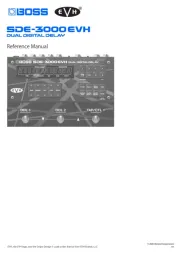
27 Januari 2025

30 November 2024

30 November 2024

30 November 2024

30 November 2024

30 November 2024

30 November 2024

30 November 2024
Handleiding Niet gecategoriseerd
- Ctek
- Scandes
- Dayclocks
- Smith & Wesson
- Total
- Deye
- Hikmicro
- Neutrik
- Innoliving
- CasaFan
- Sauber
- Tecnoware
- Smart Strip
- Zebra
- Miomare
Nieuwste handleidingen voor Niet gecategoriseerd
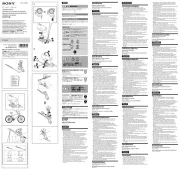
16 September 2025

16 September 2025

16 September 2025
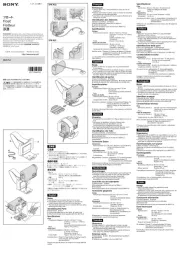
16 September 2025

16 September 2025
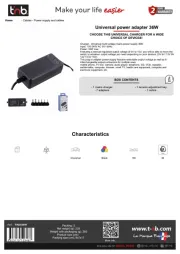
16 September 2025

16 September 2025
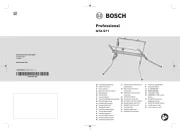
16 September 2025
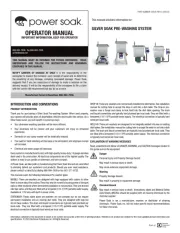
16 September 2025
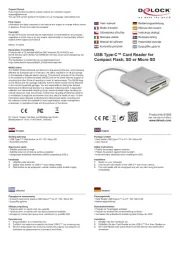
16 September 2025